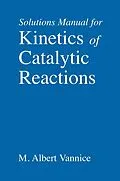This textbook contains all the information needed for graduate students or industrial researchers to design kinetic experiments involving heterogeneous catalysts, to characterize these catalysts, to acquire valid rate data, to verify the absence of mass (and heat) transfer limitations, to propose reaction models, to derive rate expressions based on these models and, finally, to assess the consistency of these rate equations.
Langmuir, Freundlich, and Temkin isotherms are derived and the former are used in Langmuir-Hinshelwood (and Hougen-Watson) models, as well as reaction sequences without a rate-determining step, to obtain rate expressions on uniform surfaces. In addition, rate equations based on non-uniform (Temkin-type) surfaces are examined as an alternative approach. The most recent technique to calculate heats of adsorption and activation barriers on metal surfaces, the BOC-MP approach, is discussed in detail. Methods to measure metal surface areas and crystallite sizes using x-ray diffraction, transmission electron microscopy and various chemisorption techniques are discussed. Different experimental techniques to determine the influence of mass transfer limitations, especially within the pores of a catalyst, are reviewed in detail, with a particular emphasis on liquid-phase reactions.
Many illustrations of these and other topics are provided along with numerous problems and a Solutions Manual for instructors. This book will be applicable to any graduate course in chemical engineering, chemistry or materials science that involves kinetics of catalytic reactions, including those catalyzed by enzymes.
Autorentext
After doing undergraduate work at Michigan State University, and graduate work at Stanford, Dr. Vannice did a post doc at Sun Oil Company before joining Exxon. In 1976 he moved to Pennsylvania State University, where he remains. After holding the M.R. Fenske Professor of Chemical Engineering, he became the W.H. Joyce Chair in Chemical Engineering, which position he holds now.
Dr. Vannice belongs to ACS, AIChE, has served first as Secretary and then as Director of the New York Catalysis Society, and has served on the Board of Directors of, as the Vice-President of, and then as President of the North American Catalysis Society. He spent seven years as an Associate Editor of the Journal of Catalysis, and continues on its Editorial Board.
Dr. Vannice has received numerous honors from his colleagues, including the Emmett Award (North American Catalysis Society), the Humboldt Senior Research Award, and the Senior Fulbright Award.
Dr. Vannice has over 250 publications and 9 patents.
Zusammenfassung
This manual of solutions to the problems in "Kinetics of Catalytic Reactions" has been prepared to assist those who use this book in a teaching function. However, these solutions should also benefit those outside the classroom who want to apply the principles and concepts that are discussed in the book. By studying and observing the approaches used in solving these problems, it is very likely that similar applications can be envisioned in different kinetic problems that the investigator might face. Thus the availability ofthese solutions is a good learning tool for everyone. Additional details and insight about the solutions provided can be obtained by reading the cited references. I have tried to eliminate all errors, both conceptual and typographical, in these solutions; however, the probability is high that I have not succeeded completely. Should any errors of commission (or omission) be found, I would greatly appreciate being informed. I can be reached at this email address: mavche@engr.psu.edu, or mail can be sent to me at: 107 Fenske Laboratory, Department of Chemical Engineering, The Pennsylvania State University, University Park, PA 16802. Albert Vannice v Contents Preface v Solutions to Problems Chapter 3 - Catalyst Characterization .
Inhalt
Catalyst Characterization.- Acquisition and Evaluation of Reaction Rate Data.- Adsorption and Desorption Process.- Kinetic Data Analysis and Evaluation of Model Parameters for Uniform (Ideal) Surfaces.- Modeling Reactions on Uniform (Ideal) Surfaces.- Modeling Reaction on Nonuniform (Nonideal) Surfaces.- Kinetics of Enzyme-Catalyzed Reactions.
